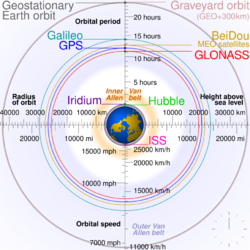Astronomy:Medium Earth orbit

belt]]s and the Earth to scale.[lower-alpha 1] The Moon's orbit is around 9 times as large as geostationary orbit.[lower-alpha 2] (In the SVG file, hover over an orbit or its label to highlight it; click to load its article.)]]

A medium Earth orbit (MEO) is an Earth-centered orbit with an altitude above a low Earth orbit (LEO) and below a high Earth orbit (HEO) – between 2,000 and 35,786 km (1,243 and 22,236 mi) above sea level.[1]
The boundary between MEO and LEO is an arbitrary altitude chosen by accepted convention, whereas the boundary between MEO and HEO is the particular altitude of a geosynchronous orbit, in which a satellite takes 24 hours to circle the Earth, the same period as the Earth’s own rotation. All satellites in MEO have an orbital period of less than 24 hours, with the minimum period (for a circular orbit at the lowest MEO altitude) about 2 hours.[2]
Satellites in MEO orbits are perturbed by solar radiation pressure, which is the dominating non-gravitational perturbing force.[3] Other perturbing forces include: Earth's albedo, navigation antenna thrust, and thermal effects related to heat re-radiation.
The MEO region includes the two zones of energetic charged particles above the equator known as the Van Allen radiation belts, which can damage satellites’ electronic systems without special shielding.[4]
A medium Earth orbit is sometimes called mid Earth orbit[1] or intermediate circular orbit (ICO).[2]
Applications
Two medium Earth orbits are particularly significant. A satellite in the semi-synchronous orbit at an altitude of approximately 20,200 kilometres (12,600 mi) has an orbital period of 12 hours and passes over the same two spots on the equator every day.[1] This reliably predictable orbit is used by the Global Positioning System (GPS) constellation.[2] Other navigation satellite systems use similar medium Earth orbits including GLONASS (with an altitude of 19,100 kilometres, 11,900 mi),[5] Galileo (with an altitude of 23,222 kilometres, 14,429 mi)[6] and BeiDou (with an altitude of 21,528 kilometres, 13,377 mi).[7]
The Molniya orbit has a high inclination of 63.4° and high eccentricity of 0.722 with a period of 12 hours, so a satellite spends most of its orbit above the chosen area in high latitudes. This orbit was used by the (now defunct) North American Sirius Satellite Radio and XM Satellite Radio satellites and the Russian Molniya military communications satellites, after which it is named.[1]
Communications satellites in MEO include the O3b and O3b mPOWER constellations for telecommunications and data backhaul to maritime, aero and remote locations (with an altitude of 8,063 kilometres, 5,010 mi).[8]
Communications satellites to cover the North and South Pole are also put in MEO.[9]
Telstar 1, an experimental communications satellite launched in 1962, orbited in MEO.[10]
In May 2022, Kazakhstani mobile network operator, Kcell, and satellite owner and operator, SES used SES's O3b MEO satellite constellation to demonstrate that MEO satellites could be used to provide high-speed mobile internet to remote regions of Kazakhstan for reliable video calling, conferencing and streaming, and web browsing, with a latency (delay) five times lower than on the existing platform based on geostationary orbit satellites.[11][12]
See also
Notes
- ↑ Orbital periods and speeds are calculated using the relations 4π2R3 = T2GM and V2R = GM, where R = radius of orbit in metres, T = orbital period in seconds, V = orbital speed in m/s, G = gravitational constant ≈ 6.673×10−11 Nm2/kg2, M = mass of Earth ≈ 5.98×1024 kg.
- ↑ Approximately 8.6 times (in radius and length) when the moon is nearest (363 104 km ÷ 42 164 km) to 9.6 times when the moon is farthest (405 696 km ÷ 42 164 km).
References
- ↑ 1.0 1.1 1.2 1.3 Catalog of Earth Satellite Orbits. NASA Earth Observatory. 4 September 2009. Accessed 2 May 2021.
- ↑ 2.0 2.1 2.2 "Definitions of geocentric orbits from the Goddard Space Flight Center". User support guide: platforms. NASA Goddard Space Flight Center. http://gcmd.nasa.gov/User/suppguide/platforms/orbit.html.
- ↑ Bury, Grzegorz; Sośnica, Krzysztof; Zajdel, Radosław; Strugarek, Dariusz (February 2020). "Toward the 1-cm Galileo orbits: challenges in modeling of perturbing forces". Journal of Geodesy 94 (2): 16. doi:10.1007/s00190-020-01342-2. Bibcode: 2020JGeod..94...16B.
- ↑ "Popular Orbits 101". Aerospace Security. 26 October 2020. Accessed 2 May 2021.
- ↑ "The Global Navigation System GLONASS: Development and Usage in the 21st Century". 34th Annual Precise Time and Time Interval (PTTI) Meeting. 2002. http://www.dtic.mil/cgi-bin/GetTRDoc?Location=U2&doc=GetTRDoc.pdf&AD=ADA484380.
- ↑ Galileo Satellites.
- ↑ BeiDou Navigation Satellite System Signal In Space. China Satellite Navigation Office. December 2013. Access 2 May 2021.
- ↑ O3b satellites.
- ↑ Satellite Basics: Solution Benefits. .
- ↑ "Medium Earth Orbit". http://iml.jou.ufl.edu/projects/Fall99/Coffey/MEO.HTM.
- ↑ Kcell, SES demo O3b satellite-enabled remote mobile services Comms Update. 26 May 2022. Accessed 30 May 2022
- ↑ "Kcell and SES Successfully Demonstrate Cellular Network connectivity in Kazakhstan" (Press release). SES. 25 May 2022. Retrieved 30 May 2022.
 |

